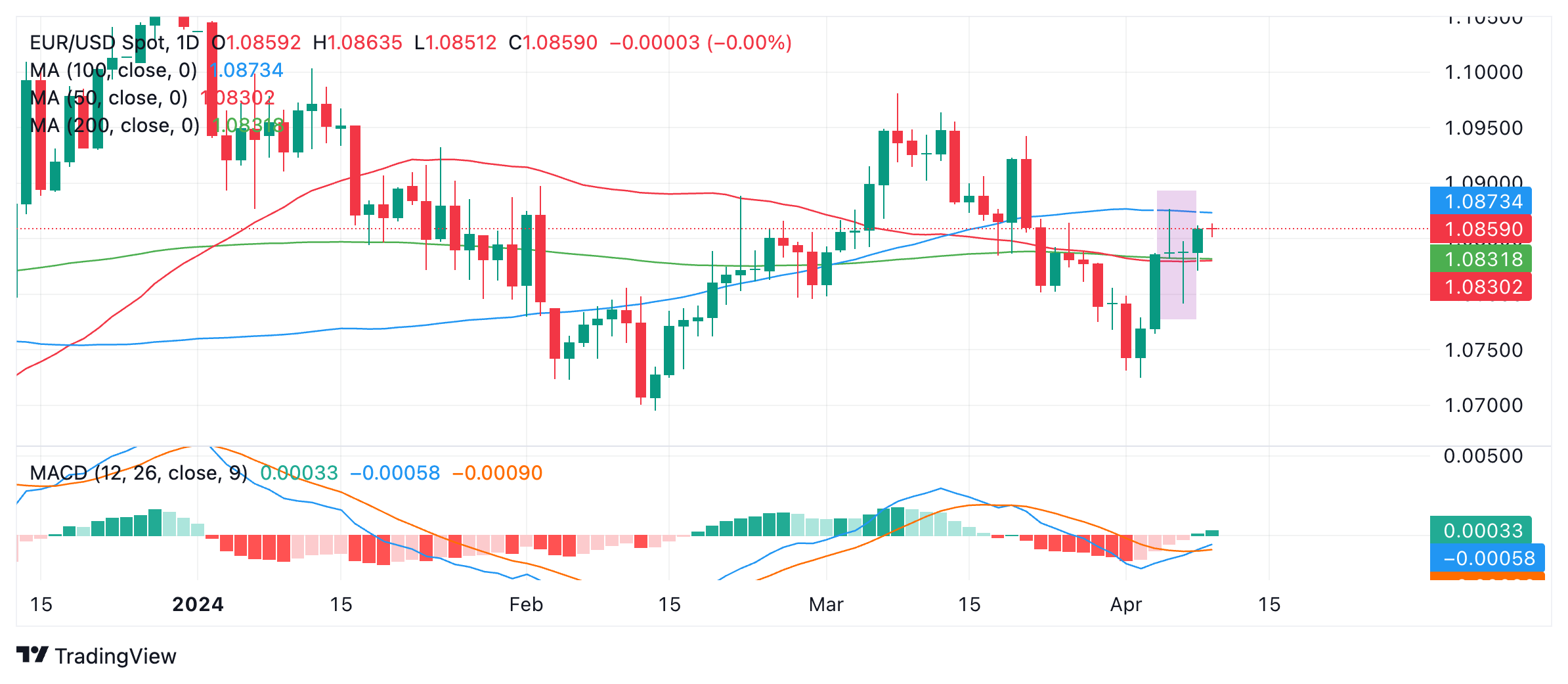- The EUR/USD pair is rangebound as traders await the next market move, US CPI data on Wednesday.
- Inflation expectations in the US are high, while US Treasury yields have reached a new yearly high.
- The pair is trading within a tight range between the 50, 100 and 200 day simple moving averages.
The EUR/USD pair is trading sideways, oscillating between tepid gains and losses around the 1.0860 area on Tuesday. The lack of volatility could be because many traders chose to stay on the sidelines awaiting the first big market move of the week, the US Consumer Price Index (CPI) inflation data for March, expected for Wednesday.
EUR/USD traders retreat to patiently wait for inflation data
The EUR/USD pair is not likely to see much volatility until the CPI release. Economists expect data to show that prices in the US rose 3.4% year-over-year in March (3.7% year-on-year for staples), both still well above the Federal Reserve's 2.0% target. (Fed). A more substantial decline is required before the Fed is likely to lower interest rates from their current level of 5.5%.
For EUR/USD, the maintenance of higher interest rates in the US compared to the Eurozone is a bearish factor. This is because relatively higher interest rates encourage foreign capital inflows.
Unlike the Fed, the European Central Bank (ECB) is seen as more likely to cut interest rates sooner amid more moderate growth and inflation expectations.
US Treasury yield hits highest level so far this year
US Treasury yields, a key indicator of inflation expectations, hit their highest level on Monday, with the 10-year Treasury yield hitting a yearly high of 4.46%. Yields in the US are highly correlated with the US Dollar and therefore negatively correlated with the EUR/USD pair. Since Monday's high, they have recovered and trended slightly lower.
US inflation expectations rose following Friday's stellar Nonfarm Payrolls (NFP) employment report, which showed another 303,000 workers joining the economy in March.
More people working usually means more people earning and spending money. This should be negative for EUR/USD, however, the pair has been broadly rising over the past five days.
Monday's release of better-than-expected German industrial production data could have helped the Euro at the start of the new week.
According to Gregor Horvat of advisory firm Wavetraders, German yields are rising faster than US yields, which could explain why the EUR/USD pair continues to rise despite good US data.
Horvat uses Elliott Wave analysis, a type of cycle theory, and expects EUR/USD to continue rising to 1.0920 before the ECB meeting on Thursday.
Technical Analysis: EUR/USD appears increasingly range-bound
In the short term, the EUR/USD pair looks increasingly range-bound.
The pair failed to confirm the bearish Gravestone Doji candle posted on Thursday, as the price recovered the next day and posted a bullish Dragonfly Doji candle – one canceling out the other (shaded rectangle on the chart).
EUR/USD Daily Chart

EUR/USD appears trapped between the clamps of three significant moving averages. The 50-day and 200-day SMA offer support at 1.0830 and 1.0831 and the 100-day SMA shows resistance at 1.0873.
A decisive break above the 100-day SMA would support the bullish case, and would see a rally to perhaps the March 21 high at 1.0942.
Alternatively, a decisive break below the cluster of MAs at 1.0835 could see a pullback evolve downwards to support at the April 2 lows at 1.0725.
Frequently asked questions about the Euro
What is the Euro?
The Euro is the currency of the 20 countries of the European Union that belong to the euro zone. It is the second most traded currency in the world, behind the US dollar. In 2022, it accounted for 31% of all foreign exchange transactions, with an average daily volume of more than $2.2 trillion per day.
EUR/USD is the most traded currency pair in the world, accounting for an estimated 30% of all transactions, followed by EUR/JPY (4%), EUR/GBP (3%) and EUR/AUD (2% ).
What is the ECB and how does it influence the Euro?
The European Central Bank (ECB), headquartered in Frankfurt, Germany, is the reserve bank of the euro zone. The ECB sets interest rates and manages monetary policy
The ECB's main mandate is to maintain price stability, which means controlling inflation or stimulating growth. Its main instrument is to raise or lower interest rates. Relatively high interest rates – or the expectation of higher rates – tend to benefit the Euro and vice versa.
The Governing Council of the ECB takes monetary policy decisions at meetings held eight times a year. Decisions are made by the heads of the eurozone's national banks and six permanent members, including ECB President Christine Lagarde.
How do inflation data influence the value of the Euro?
Eurozone inflation data, measured by the Harmonized Index of Consumer Prices (HICP), are important econometric data for the euro. If inflation rises more than expected, especially if it exceeds the 2% target set by the ECB, it is forced to raise interest rates to bring it back under control.
Relatively high interest rates compared to their peers tend to benefit the Euro, as it makes the region more attractive as a place for global investors to park their money.
How do economic data influence the value of the Euro?
Data releases measure the health of the economy and can influence the Euro. Indicators such as GDP, manufacturing and services PMIs, employment and consumer sentiment surveys can influence the direction of the single currency.
A strong economy is good for the Euro. Not only does it attract more foreign investment, but it may encourage the ECB to raise interest rates, which will directly strengthen the Euro. Conversely, if economic data is weak, the Euro is likely to fall.
The economic data for the four largest economies in the eurozone (Germany, France, Italy and Spain) are especially significant, as they represent 75% of the eurozone economy.
How does the trade balance affect the Euro?
Another important release for the euro is the trade balance. This indicator measures the difference between what a country earns from its exports and what it spends on imports during a given period.
If a country produces highly sought-after export products, its currency will appreciate due to the additional demand created by foreign buyers wishing to purchase these goods. Therefore, a positive net trade balance strengthens a currency and vice versa for a negative balance.
Source: Fx Street
I am Joshua Winder, a senior-level journalist and editor at World Stock Market. I specialize in covering news related to the stock market and economic trends. With more than 8 years of experience in this field, I have become an expert in financial reporting.







